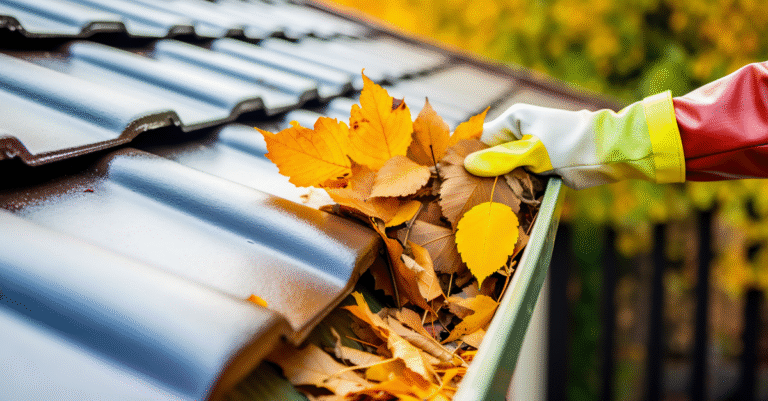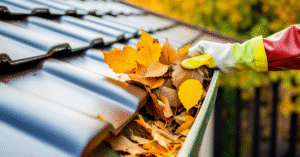As the leaves turn and temperatures drop, there’s more to fall than pumpkin spice and cozy evenings by the fire. It’s also the season to get your home ready for winter weather.
A little preparation now can help homeowners avoid unexpected repairs, lower utility bills, and protect their biggest investment: their home. Whether you’re a new homeowner or a seasoned pro, this fall home maintenance checklist can help you stay one step ahead.
Inspect Your Roof and Gutters
Falling leaves may be beautiful, but they can cause major headaches if they block your gutters or downspouts. Clogged gutters can lead to ice dams and water damage once temperatures dip. In fact, water damage and freezing accounted for 27.6 % of homeowners insurance claims in 2022.
Clear out leaves and debris, check for loose shingles, and make sure water flows away from your foundation. Consider installing gutter guards: a 2025 survey found that 63 % of homeowners saved at least four hours a year in gutter maintenance after installing them.
By taking these steps now, you can help prevent costly repairs and avoid structural damage before winter sets in.
Seal Windows and Doors to Keep Warm Air In
Drafts aren’t just uncomfortable, they’re costly. A simple inspection around windows and doors can save energy and money. The Department of Energy estimates you can save up to 20 % on heating bills by sealing drafts and replacing inefficient windows. Use weatherstripping or caulk to seal leaks, and check that window locks and seals are tight. If you notice cold air seeping in, it might be time for an upgrade that boosts comfort and resale value.
Sealing up your home now not only adds comfort for this season and protects against higher utility bills later.
Schedule a Furnace Tune-Up
Your heating system works hardest when you need it most. Don’t wait until the first cold night to find out it’s not performing at its best. Have a professional inspect and clean your HVAC system to ensure it’s efficient and safe for winter. Replace filters regularly to keep your system running smoothly.
While you’re at it, vacuum vents and baseboards to remove dust buildup — clean airflow helps your system run efficiently and improves indoor air quality.
An inefficient furnace costs more to operate and may fail early. A furnace failure puts you at risk when you need it most.
Check Smoke and Carbon Monoxide Detectors
With fireplaces, space heaters, and furnaces working overtime, fall is the perfect time to test your home’s safety systems. Replace batteries in smoke and CO detectors, and make sure every level of your home has at least one working alarm.
According to industry data, water damage and freezing issues are the second leading cause of insurance claims after wind and hail.
An unexpected malfunction or leak can trigger far more than a draft — it can lead to significant cost and risk.
Protect Your Pipes and Plumbing
Frozen pipes are one of winter’s most common (and costly) issues. For example, a small crack in a pipe can leak gallons of water a day, causing serious damage. Drain outdoor spigots, disconnect hoses, and wrap exposed pipes in unheated areas like basements or garages.
These inexpensive steps now can prevent expensive repairs later. The average frozen pipe repair can exceed $500 and sometimes runs into the thousands.
Fire Up Your Fireplace (Safely)
Before lighting the first fire of the season, make sure your chimney and flue are clean and in good working order. Schedule a professional inspection to remove creosote buildup and check for blockages. Safety first, comfort always.
A small investment in inspection now can save from major fire risk, structural damage, and homeowner disruption later.
Prep Outdoor Spaces for Winter
Patios, decks, and garden areas need care before freezing temps set in. Store or cover patio furniture, turn off irrigation systems, and trim trees or branches close to your roofline and power lines.
Taking care of your outdoor spaces now means less hassle and more enjoyment when spring rolls around.
Check Your Home's Energy Efficiency
Now’s also a great time to review your home’s energy use. Consider an energy audit or small upgrades, like LED lighting or a smart thermostat, to cut utility costs and increase comfort. Reverse your ceiling fans to clockwise rotation — it helps push warm air back down, reducing heating costs.
And if you’re planning major improvements, your home’s equity can help fund energy-efficient upgrades or repairs before winter arrives. Ask your NewFed loan officer about options like home equity refinancing or renovation loans that make energy upgrades more affordable.
Plan Ahead for a Stress-Free Season
Preparing your home for winter doesn’t have to be overwhelming. With this fall checklist, you’ll feel confident that your home is safe, comfortable, and ready for the season ahead.







